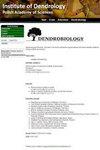Morphology of strobili at different development positions and cone and seed characteristics of Pinus densiflora f. multicaulis
IF 1.8
4区 农林科学
Q2 FORESTRY
引用次数: 1
Abstract
Pinus densiflora f. multicaulis is a rare and unusual form of genus Pinus. It has excellent ornamental values due to many trunks from its root collar, and produces female, male, and bisexual strobili on thes ame tree. However, there is limited study whether the bisexual strobili are functional, mature lateral conesproduce filled seeds, and the seeds from the mature lateral cones germinate and grow as well as those frommature apical cones. The structure of apical female, and lateral male and bisexual strobili were analyzed in an open-pollination-progeny population. The strobili were photographed to obtain external, cross-section, and radial-section images using a 45× stereoscopic microscope. Radial sections of strobili were imaged using scanning electron microscopy. Characteristics of apical and lateral cones and seeds were surveyedby cone analysis and germination test. P. densiflora f. multicaulis developed typical female strobili apically,and ordinary male and bisexual strobili laterally. Additionally, female strobili developed laterally whereas the male strobili were normally located. The mature lateral female strobili had the same structure as the apical female. In the mature bisexual strobili, the proportion of male and female tissue was unequal. The cones developed from lateral female strobili showed highly significant differences in the length, width, and weight, being shorter (32.7%), narrower (26.9%), and lighter (59.8%) than those from apical female strobili. Both types produced filled seeds and seedlings, and well significant positive correlations were found among characteristics of seeds from apical and lateral female strobili. The initial seed germination rate of the seeds from apical female strobili was higher than that of seeds from lateral female strobili, but the difference decreased over time. The viability and spatial distribution of the female and male tissue of bisporangiate cones, and their frequent occurrence suggests a common mechanism for the production of bisporangiate structures in seed plants.多毛松不同发育部位球果形态及球果和种子特性
松(Pinus densiflora f. multicaulis)是一种罕见的松属植物。它有极好的观赏价值,因为它的根颈有许多树干,在这棵同树上产生雌性、雄性和两性的strobili。然而,关于双性球果是否具有功能性、成熟的侧生球果是否产生饱满的种子、成熟的侧生球果的种子是否与成熟的顶生球果的种子一样发芽和生长的研究却很少。对一个开放传粉后代群体的顶部雌花、侧面雄花和两性花的结构进行了分析。利用45倍立体显微镜对球果进行外景、横切面和径向成像。利用扫描电镜对桔梗的径向切片进行了成像。通过球果分析和发芽试验对其顶、外侧球果和种子的特性进行了研究。多茎密花上部发育典型的雌性密花,侧面发育普通的雄性和两性密花。此外,雌球果呈外侧发育,而雄球果呈正常分布。成熟的外侧雌花与顶端雌花结构相同。在成熟的双性水杨花中,雌雄组织的比例不相等。雌球果的长、宽、重差异显著,分别比雌球果短(32.7%)、窄(26.9%)、轻(59.8%)。两种类型均能产生饱满的种子和幼苗,且顶端和外侧雌花的种子性状之间存在极显著的正相关。顶部雌花的种子初始发芽率高于侧部雌花的种子,但随着时间的推移,差异逐渐减小。双孔体球果雌、雄组织的生存力、空间分布及其频繁出现提示了种子植物双孔体结构产生的共同机制。
本文章由计算机程序翻译,如有差异,请以英文原文为准。
求助全文
约1分钟内获得全文
求助全文
来源期刊

Dendrobiology
农林科学-林学
CiteScore
2.20
自引率
11.10%
发文量
17
审稿时长
>12 weeks
期刊介绍:
Dendrobiology publishes original research articles and review articles related to the biology of trees and shrubs.
 求助内容:
求助内容: 应助结果提醒方式:
应助结果提醒方式:


